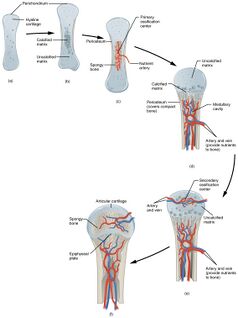Endochondral ossification
Many bones, which are then classified as long bones, are initially developed from cartilague. This is replaced by bone during a process called endochondral ossification . In other words, endochondral ossification replaces the original cartilagenous model which is destroyed in the process.
Process[edit | edit source]
During the fifth and sixth week of development of the embryo, chondroblast are differentiated from mesenchyme. Chondroblast then create a cartilagenous model, from which the shape of the future bone can alredy be recognized. Simultaneously perichondrium is developed on the surface. This model increases its width by apositional growth and its length by interstitial growth.
When the model reaches about half the lenght of the future diaphysis, osteoblast begin to differentiate within the perichondrium and they form the bone collar around the diaphysis by desmogenic ossification. Subsequently,the bone collar grows both proximally and distally and as a consequence the periostium is formed from the former perichondrium (from which the bone collar continues to grow in width).
The cartilage was previously nourished by diffusion through the perichondrium, but this changed due to the development of the bony collar - hence, the cartilage reacts to the lack of nutrients and oxygen. It begins to suffer from hypertrophy (chondroblast become bigger because of the poor metabolism, and this generates the leakage of Ca2+ into the ECM - extracellular matrix), and thereupon the calcification (mineralization)of cartilage occurs (ECM begins to calcify), which disintegrates and developes cavities.
Blood vessels go through the periosteum in the bony collar and enter the cartilaginous matrix. With them migrates mesenchyme, which contains precursors of bone cells, that then differentiate into osteoblasts. On the other hand, osteoclasts and chondroclasts develop from fetal hematopoietic centers in the liver. In the calcification center a. nutricia branches and its vessels travel in both directions until the reach the epiphysis.
Chondroclasts remove part of the mineralized (calcified) cartilagenous mass, thus creating (while being protected by the bony collar) a early bone marrow cavity. At the same time, hypertrophies chondrocytes (enlarged) undergo apoptosis. Part of the calcified cartilage persists in the form of small spikes, beams or spicules. Osteoblasts attach to these irregularities, and deposit bone product, creating the primary ossification center, which then will turn into a primitive bone - osteoid.
This will be followed by further resorption and ossification during which the lamellar bone replaces the osteid. Growth cartilage persists in the epiphysis .The ossification of the epihysis begins during the final stage of development or during the first months or years after birth.
Links[edit | edit source]
Related articles[edit | edit source]
References[edit | edit source]
- LÜLLMANN-RAUCH, Renate. Histologie. 1. edition. Praha : Grada, 2012. 576 pp. ISBN 978-80-247-3729-4.
- ČIHÁK, Radomír – GRIM, Miloš. Anatomie. 2.. edition. Praha : Grada Publishing, 2002. 470 pp. vol. 1. ISBN 80-7169-970-5.

